How to Build a Content Database (with Templates)

Sorry, there were no results found for “”
Sorry, there were no results found for “”
Sorry, there were no results found for “”
Content creation usually starts simply enough: You or your company have an audience, your audience has questions, and you want to address those questions.
Maybe you start with a blog, a social media post, or a landing page. And then another, and another, and another. Before you know it, you have, well, a lot of content.
But did you organize it? And is your organizational system scalable?
If your answer to either of these questions is somewhere between a “meh” and a “no,” don’t worry! You’re not alone! After all, it’s hard to anticipate needs before they arise, especially in a practice as fast-paced and ever-evolving as content marketing.
In fact, the ClickUp Marketing and Creative teams have been reckoning with the side-effects of rapid growth in content, team members, processes, and everything in between. So naturally, we used ClickUp to create a more organized system. And we want to share it with you!
A content database describes a system by which a person or team consolidates content and its context (think launch date, status, analytics) in a standardized way. This is done to make building and maintaining content-based campaigns easier.
Most larger teams maintain a database for each type of content they need to track—landing pages, blogs, advertisements, social media posts—but smaller teams or individuals might be able to keep all their content in a single database, categorizing content by type.
While the information and free templates in this blog are meant to serve as general guidelines to help you build and maintain your own database, there will always be some trial and error involved as you determine what components you need to keep track of all your stuff in one place.
A quick word on database types
A distinction you’ll often hear when discussing databases is relational versus non-relational databases.
To put it simply, a relational database stores information in tables and connects related tabular information. These connections between different data points in different tables are called schema. Data analysts find information in a relational database by searching for information via a domain-specific language like SQL.
Non-relational databases, on the other hand, are not necessarily structured in tables. They are optimized for the type of content they hold, and a non-relational database might consist of multiple ways of presenting, labeling, and searching for information.
Because ClickUp allows you to create no-code relational databases for your work, your finished content database will more closely resemble a traditional relational database: labels and categories will be standardized, and information will be displayed in tables. However, nothing in this blog will require any knowledge of SQL or any other programming language.
With that brief disclaimer out of the way, let’s get started!
Before you spend hours planning, organizing, and building a database, it’s worth making sure you and your team will actually benefit from it.
You might be asking, “What kind of teams actually use content databases?”
The simple answer is pretty much anyone or any team with large amounts of content that they need to organize, track, and update—emphasis on the track and update parts. A good database won’t just help you find content, it will also allow you to add metrics, statuses, and qualitative info to that content so you can determine:
So if you or your team have found yourselves asking any of these questions, then it’s worth your time to at least consider a content database.
Content databases are useful for organizing assets for any type of team, but they usually track information for:
While this post will explain databases in the context of a Content Marketing team, the information is applicable to anyone trying to manage large amounts of content.

As teams become more distributed and numerous, it becomes increasingly challenging to remain at the core of the business since any flaws or disruptions in procedures are amplified. The ClickUp Marketing Teams Template provides a solution to better collaborate by consolidating all marketing tasks, improving visibility across the marketing department, and allowing for rapid response.
Whether you’re a team of one or one hundred, your reasons for building a content database will probably fall into one or more of the following categories:
While each of these factors played a role in the ClickUp Marketing team’s decision to build blog and landing page databases, our biggest need was scalability.
With every team growing rapidly, we needed a way to take the massive amounts of information that lived in the minds of a few people and make it available to a brand new team unfamiliar with years of ClickUp-specific processes and programs.
But scalability is just one of the benefits of a well-maintained content database. Let’s dive into the others:
ClickUp’s main deal is to save you one day every week, so let’s be real, “saves you time” was always going to be our number one. But that doesn’t make it any less true! After all, if content isn’t grouped together in a standardized way, that means it’s either:
Having everything stored in a database, on the other hand, is like having all your needles in a single drawer labeled “needles” so you don’t have to go digging through haystacks to finish your embroidery project.
Simply put, if you spend less time looking for stuff, you have more time to work on building and improving it.
When everyone knows where to find something, it also ensures your team won’t be duplicating efforts by creating something that already exists from scratch because they couldn’t find it. Because let’s be honest, at one point or another we’ve all just recreated a piece of content because it was easier than going on a scavenger hunt looking for it.
What’s more, storing content in a database—especially a cloud-based one—makes sure everyone knows where to find the latest version of something.
Left to their own devices, pretty much everyone will come up with their own organizational system.
When you’re the only person who needs to use it, that’s fine. If one or two others need to learn your system, even if it is a little haphazard, that’s usually okay.
But when a team grows so that ten, then twenty, then a hundred people need to adapt to an improvised system that was made by one person and often for one person, you’ve got a problem.
The idea of a well-structured content database is to prevent that problem before it arises. So even if you’re currently a team of one and you organize all your content in a way that works for you, consider whether that system will still work when dozens of other people need to use it.
If your answer is “maybe” or “😬” then it might be time to get a bit more structured and strategic with your content tracking.
One of the biggest benefits of a well-structured database is that it allows people to not only find things (if that were the case it’d just be a content library) but also that it gives content context. That is, it allows you to see quantitative data such as traffic, engagement, status, and history that can help you improve specific content and improve overall content development.
And when everyone has access to a database, everyone can ideate using the same context, which can give rise to some insightful new ways to approach content.
For example, when running a social media audit, a specialist might look at a high-traffic, high-engagement blog post in a content database and realize that it includes statistics that can be used to create a series of LinkedIn posts. An email marketer might see the same post and realize it includes a process breakdown that would make a great infographic for an upcoming newsletter.
Simply contextualizing content and making it available to everyone allows for greater group insights and encourages the atomization of top-performing content.
Organizing and tracking everything in one place also makes it easier for data teams to compare content performance so they can assess what’s working and what’s not, and make appropriate changes to paid or organic content strategies.
Deciding what information to include in your content database will vary based on what kind of content you’re tracking and why you’re tracking it, but here are some good guidelines to follow:
First, you must figure out what kind of assets—webpages, social media posts, blogs, or all of the above—you need to organize and track. Then, you must decide how you will track these assets.
If the content you are tracking can be thought of as a collection of items, then “how you track it” is the storage containers you use to organize the material. You should select a storage container that is easy to pack, fits all the necessary information, and can be easily labeled and located later.
If you’re using ClickUp to build a database, we suggest using tasks to store individual pieces of content. But we’ll cover this in more detail in our next section.
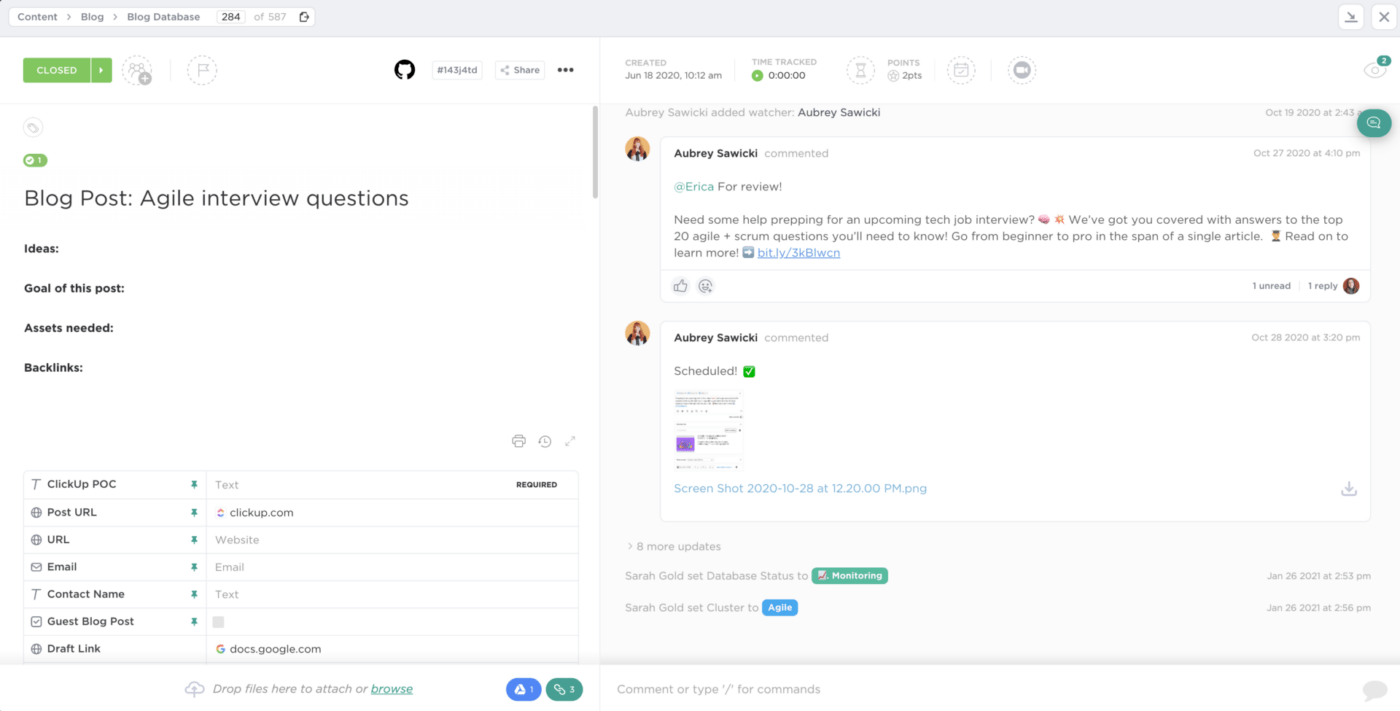
Once you’ve decided what type (or types) of content you’re tracking and how you’re storing it, you must decide how to categorize it.
In ClickUp’s case, we keep a separate database for blogs and landing pages, and we categorize each by category.
Blogs are clustered by topic, so we include a Custom Field with options such as Agile, CRM, Tools, Work/Life, etc.
Landing pages are clustered by type, so that the same Custom Field in a landing page task contains options such as Feature, Competitor, Team, etc.
When coming up with your own labels, regardless of whether or not you decide to categorize by topic, remember that using labels consistently is the most important thing. Make sure you and your team understand what each label means, and make sure the spelling and capitalization of labels are consistent.
Now that you’ve decided what you’re storing in your database and how you’re organizing it, you can start to fill in the details. At this stage, you want to consider a few key questions:
Answering these questions will help you decide what information you need to include in your database tasks. (Or, if you’re not using ClickUp, whatever “container” you’re using to store information about the content.)
We’ll look at some of the specific details we track in our database in the next section.
A database is only useful if it helps you and your team consolidate information and streamline existing workflows.
After all, if you don’t want to do anything with your content, why take all the time to add it to a database?
As you’re deciding what details to track, also consider how they will help you and your team tie the database to any existing processes that involve the content.
For example, say you’ve created a database for all your web pages and you need someone on your team to check posts every six months from their publish date for the accuracy of information. You’d want to make sure each web page task contains a “Review Needed” or “Update Required” status and due date. You can even add the reviewer as an assignee on the task to clearly indicate their responsibilities.

Ensuring your content is easy to find and incorporate into workflows will save your team time and make it much easier to train new team members to use the database and learn internal processes.
Additionally, tracking statuses, labels, and metrics consistently will allow you to set up automations to maintain the database and facilitate processes. More on automations in just a bit.
When deciding to create a content database for you and your team, first ensure everyone involved in the project knows the problems that this database will solve. You can do this with a simple list, such as the one shown below for a blog database:
Blog content pain points:
From these pain points, create a one- to two-sentence description for the database:
“This blog database is designed to serve as a central reference for ClickUp blogs. Please avoid creating blog tasks elsewhere in ClickUp, store all relevant blog information in the corresponding task, and update the task info when you are performing any copy edits or SEO.”
This gives current and new team members a bit of context as to how the database should be used. For instance, in the example above, we’re saying that all blog info should live in the database.
You can also use the pain points above to help decide what information to include in your database, and how to store and organize it. Do this by outlining how you intend to use the database to solve each issue:
Repeating this process for each major pain point guarantees your database is solving the right problems.
To visualize what this process results in, let’s dissect one of the tasks in ClickUp’s Blog Database:
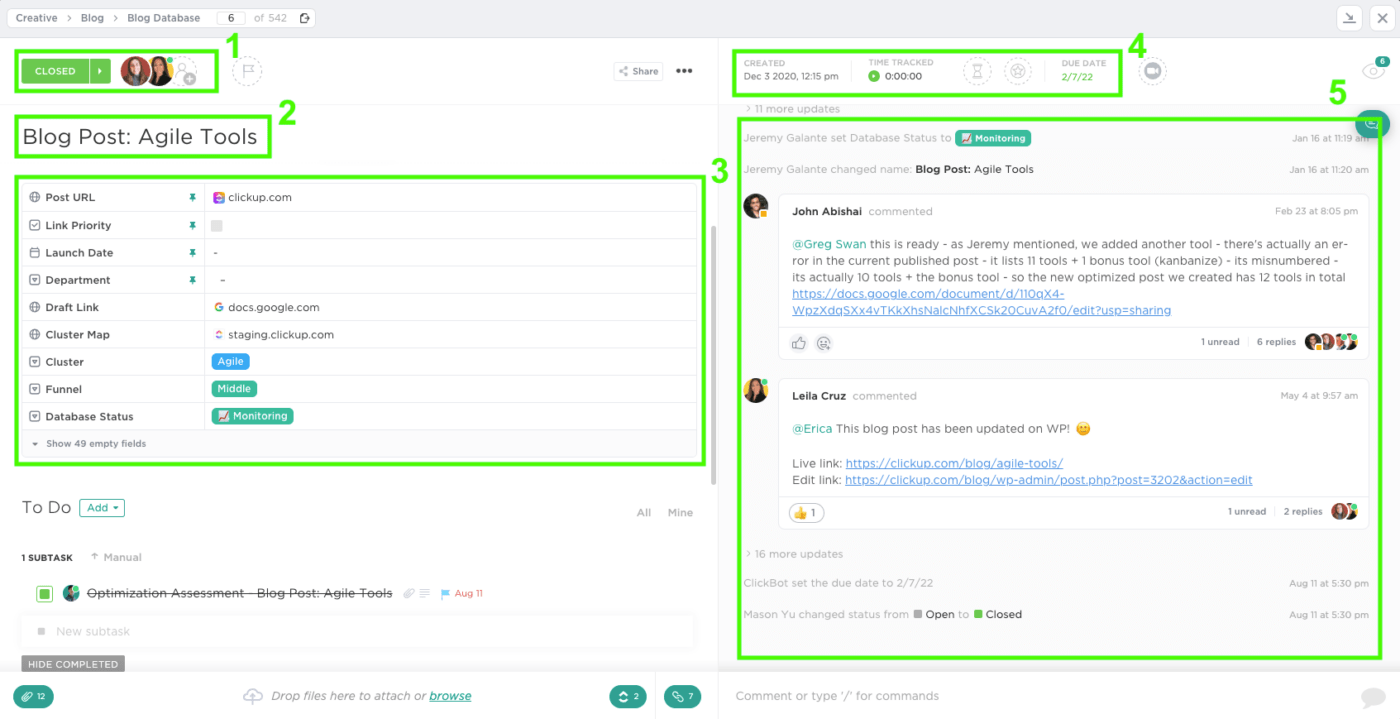
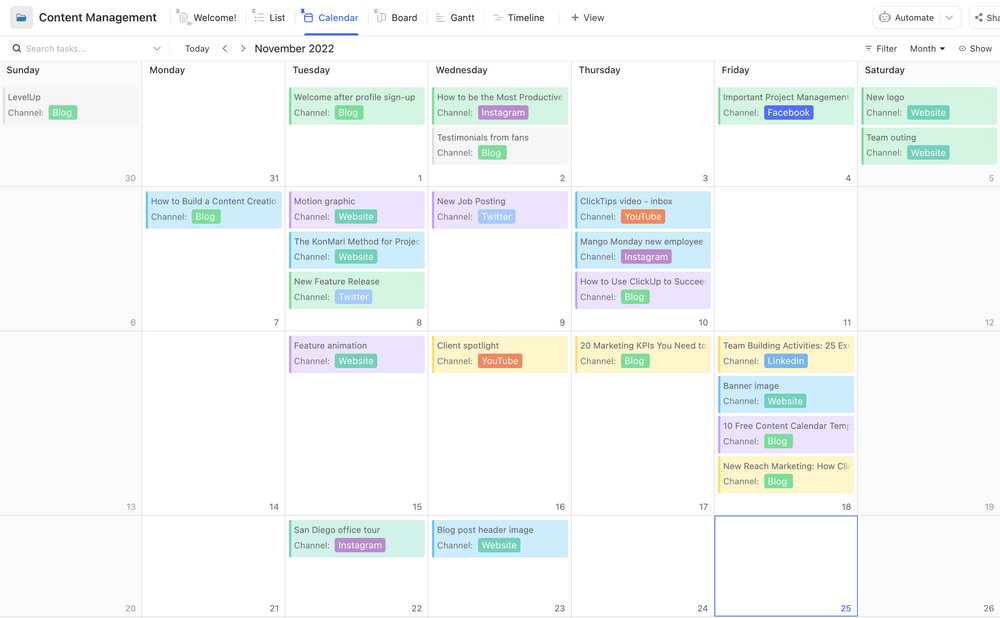
While your own database might be configured differently and contain different information from the example above, this should provide a good starting point for you and your team. With the ClickUp Content Management Template, you can easily plan and execute delivery across multiple marketing channels. It also provides clear visibility into your content distribution plan as well.
Another important consideration is how you want to review all this information high level. While having all the information for a piece of content consolidated in one place is important, it’s just as crucial to be able to quickly and easily sort, filter, group, and search for multiple pieces of content. That’s where ClickUp views come in.
While you can visualize your database any number of ways in ClickUp, we’ll be taking a closer look at two of the most “database-friendly” views here:
List view is extremely useful for quickly grouping and filtering your content in various ways to gain better insights and to draw comparisons between types of content. By default, List view will group information by Status, but ClickUp’s granular filter and sort options allow you to display content based on any variable.

As indicated above, we often group by content category, but the database could just as easily be grouped by Database Status, Assignee, Due Date, and more.
To properly utilize the many grouping, filtering, and sorting options available in list view (among others), it’s essential that you establish and maintain clear and consistent naming conventions throughout your database.
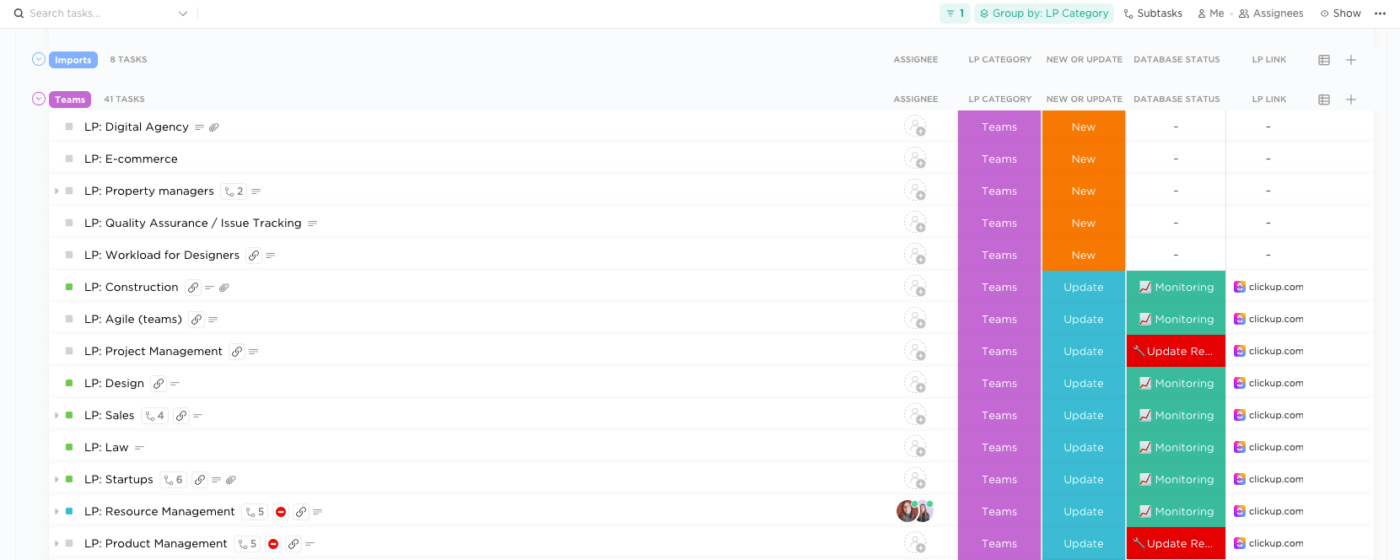
Table view gives you a high-level view of a database’s contents. This view is ideal for storing and reviewing content analytics (such as traffic, click rates, and conversion rates) and for quickly seeing what status many individual pieces of content are in.
The Table view is also extremely useful if you’re creating a no-code relational database for your content. To accomplish this, simply include Custom Field(s) that allow for the inclusion of links, which will then be accessible from the Table view, allowing users to jump to related information with just a click.
Similarly, use the relationship and dependency features within tasks to organize a clear, no-code relational database.

While these are the two views the ClickUp team most frequently uses to build and maintain database content, they’re by no means the only useful views for doing so.
A smaller database that’s highly workflow-oriented might benefit from ClickUp’s Kanban Board view.
A social media content database can also double as a content calendar via ClickUp’s Calendar view.
So don’t feel tied to a particular view when planning and building your content database—just remember to keep your categories and labels consistent so they’ll be easy to filter and group by later in any view you choose.
So your database is complete! All your content is neatly organized into tasks, which are sorted into easy-to-navigate views. Your work is done, right?
Not quite.
Now that you have a fully functional content database, it’s time to put it to work! After all, a database is supposed to make tracking, analyzing, and updating content easier. But that means you and your team still have to do the tracking, analyzing, and updating.
Before we get into the processes and workflows, let’s review a few simple ground rules that will make maintaining your database possible in the long run.
Simply put, this means making sure everyone who needs to use the database has access to it and knows where it is, how to navigate it, and how (and when) to properly update the content contained within.
If new hires need access to the database, make sure you include database instructions in their onboarding materials to streamline training.
And make sure all your internal playbooks and standard operating procedures (SOPs) are updated with explicit instructions on how to properly use the database. Otherwise, you risk playing a game of telephone with important information as SOPs get relayed verbally or in one-off emails and Slacks.
Finally, ensuring proper visibility reduces the chances that you and your team will duplicate work by creating the same content in multiple tasks or lists.
Make sure everyone knows their roles in maintaining a database. Doing so will help avoid redundancies or worse yet, a game of tug-o-war, where one person does something and then another person undoes it and so on.
All this means that maintaining a content database should be a team effort. For example, if you’re working on maintaining a blog database for a tech company, you might distribute accountability as follows:
Once you’ve determined who’s responsible for what, the next step is figuring out how each stakeholder will know when to do what.
Automations can be extremely useful because it can save your team time and minimize human error. But before automating anything, ask yourself, “What needs to happen every time my team and I create a certain piece of content?”
This is an important question to answer because many steps in a process are variable, so they might change based on content type and context. Variable steps and processes should usually be manual, as automations can cause more problems than they solve in these cases.
If the steps in a process are fixed and happen every time you create a piece of content, they are prime candidates for automation.
We’ll dive into a few automations the ClickUp team uses to maintain its blog database, but keep in mind that they are descriptive, not prescriptive, so use them as general examples rather than exact guides for setting up your own automations
Many ClickUp blog database automations serve to manage processes that take place over multiple weeks or months. After all, humans forget things over time—if configured correctly, automations don’t. Let’s take a look at a practical example of this:
One of our primary automations simplifies the various task statuses a blog goes through for easy reference in the blog database using the Database Status Custom Field:

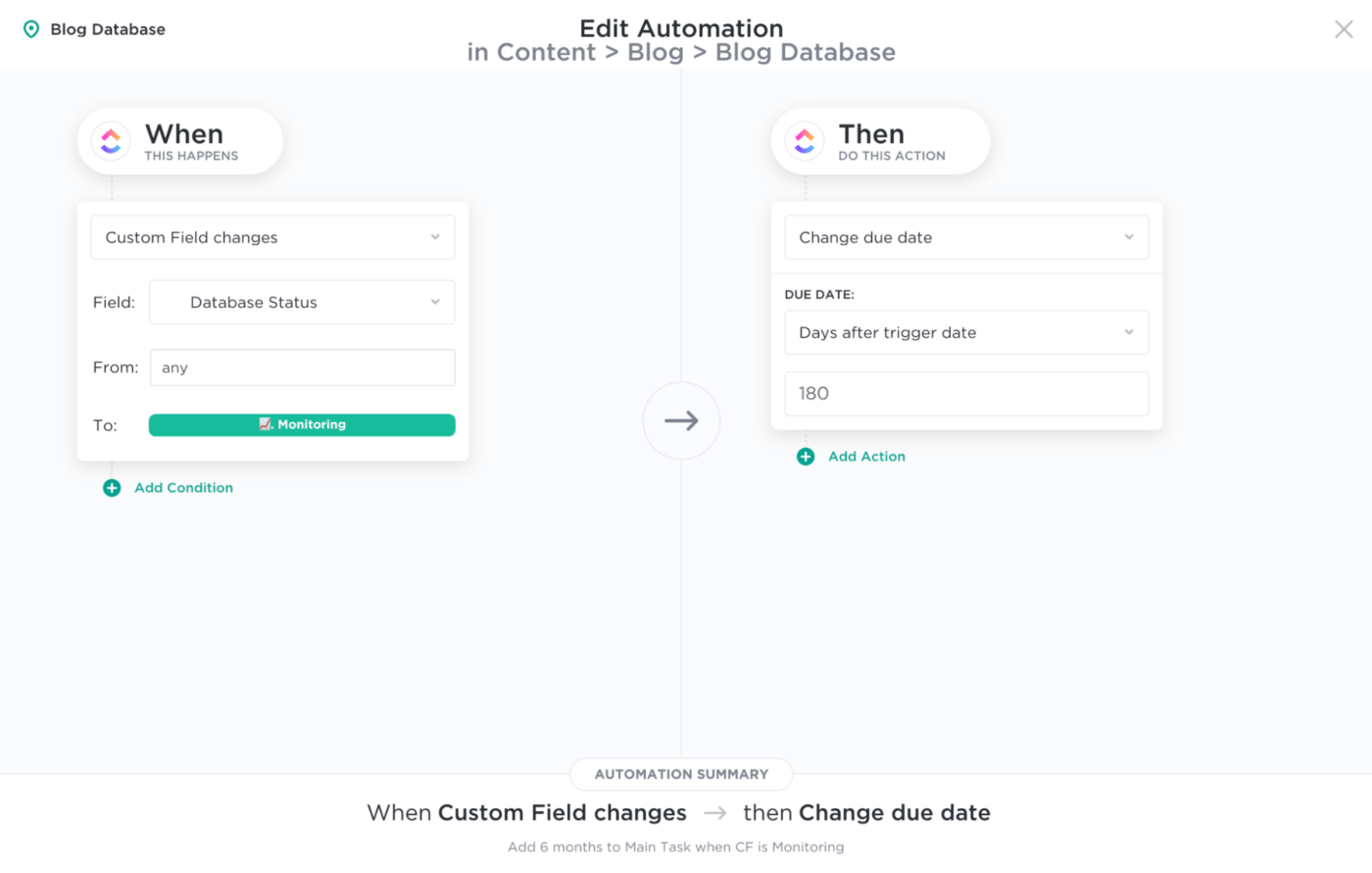
The Due Date automation ensures that the blog post’s performance will be analyzed at some point in the next six months.
A further automation is set up to ensure that, after the six months have elapsed, the Database Status Custom Field changes to Audit . This, in turn, triggers an automation to create a new performance assessment subtask, wherein the SEO team analyzes the blog’s performance and determines whether updates are needed.
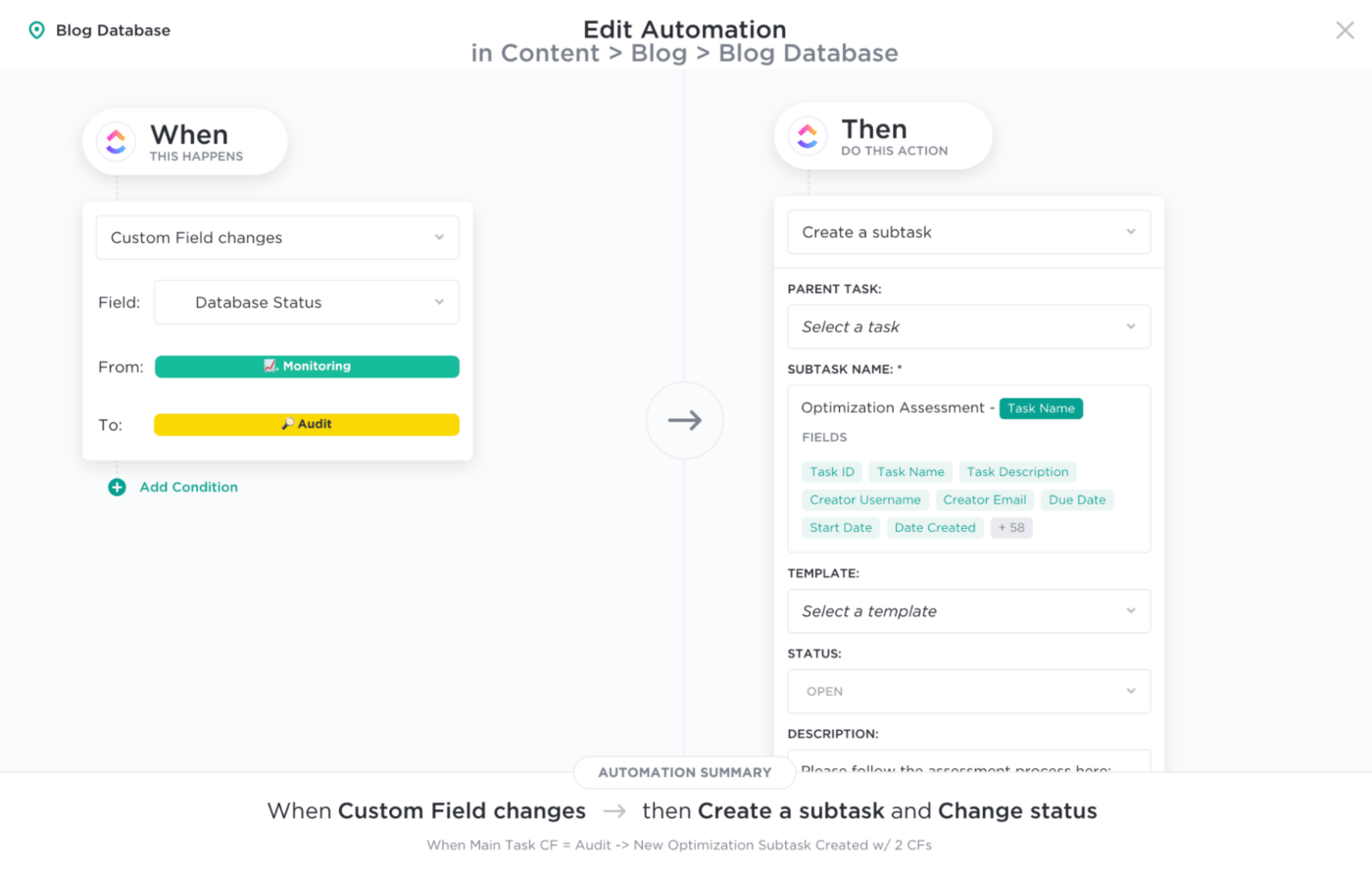
In summary, automations can help ensure that processes are standardized and prolonged workflows aren’t forgotten.
Try to keep everything as simple as possible, from naming conventions to automations. This will make finding things immeasurably easier and will make it much simpler to familiarize your team (and any future hires) with the database and the workflows it encompasses.

If you need help simplifying your workflow, use the ClickUp Creative and Design Template to build a clear breakdown of your marketing workflow. This template supports common marketing aspects like intake forms, content brief requests, and managing asset libraries, so there’s a straight path to how your content marketing process works.
The hardest part of a project like this can be getting started. After all, creating a content database is a huge undertaking that might induce analysis paralysis.
If you’re building your database from scratch, either with ClickUp or another task or project management tool, start planning for your database using the basic steps discussed in this blog:
Since outlining and keeping track of even these first steps can prove a bit overwhelming, especially if you’re dealing with a large amount or several kinds of content, try organizing your thoughts using ClickUp’s Mind Maps.
Doing so will allow you to outline your database at a high level while visualizing how the pieces relate to each other.

You can also use Docs in ClickUp to store notes and collaborate in real-time with your team on database structure and implementation. This ensures everyone is on the same page and makes it easier to delegate responsibilities when you’re ready to start building.

To get a head start on all this planning, download our free blog database and landing page database templates. These content templates are based on ClickUp’s own marketing team’s blog and landing page databases, so they’ve been tried and tested.
A final piece of advice to consider when planning, building, and maintaining your content database: involve your entire team.
Getting your whole team involved from the get-go ensures that:
If you’re in need of a great collaboration tool that also doubles as a perfect content database tool, then look no further than ClickUp. Get started with your team on our Free Forever plan, and bring your team collaboration, database tools, and work management into one place.
© 2025 ClickUp